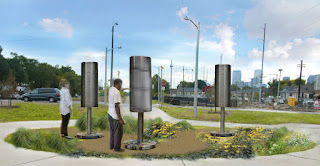 |
“Turning: prayer wheels for the Mississippi River” Artist Rendering
|
Commissioned by the Arts Council of New Orleans, the City of New Orleans, and featured in the Prospect.4 Biennial, “Turning” elegantly blends social and environmental activism with interactive sculpture, where the history of the land itself is an integral component of the piece.
“Turning” consists of three, 9 foot, stainless steel, interactive “prayer wheels”, individually cut with iconography of the Mississippi River from three distinct periods of the riverʼs history, (the wild era, colonial plantation era, and petrochemical era), based on the mapping in Kate Orffʼs seminal book, “Petrochemical America”. Each cylinder is rooted in a hand-made mosaic base that depicts the land building patterns created from deposits of the riverʼs sediment over 7000 years, informed by the Fisk maps of 1944. At night, the prayer wheels will emit pulses of dim blue light via solar power, and visitors may spin each wheel to intensify the emanations. The path that weaves through the installation echoes the riverʼs serpentine curvature, while the indigenous gardens surrounding the site were planted by Varisco and a team of devoted community volunteers.



